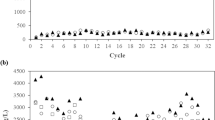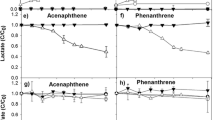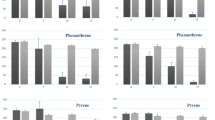Abstract
Bioaugmentation for the removal of polyaromatic hydrocarbons (PAHs) from wastewater using bacteria and yeasts is considered environment-friendly and a cost-effective technique. The effectiveness of this biodegradation system depends on the stability of inoculated microorganisms and the availability of nutrients. This study is aimed to investigate the removal of high molecular weight (HMW)-PAHs from biologically treated produced water using different biological systems. Three systems, inoculated with activated sludge (AS), the mixture of five yeast strains (MY), and the mixture of AS and the five yeast strains (SY), respectively, were constructed, and their performance for the removal of HMW-PAHs was compared over 10 weeks. The effluent of the biologically treated produced water from an oilfield was used as the influent after chrysene and benzo(a)pyrene were spiked as HMW-PAHs. Polymerase chain reaction-based denaturing gradient gel electrophoresis (PCR-DGGE) and fluorescent in situ hybridization (FISH) techniques were used to examine the changes in the structures and abundances of the bacterial and yeast communities in these three systems. Only SY and MY systems were capable to remove chrysene (90.7 % and 98.5 %, respectively) and benzo(a)pyrene (80.7 % and 95.2 %, respectively). PCR-DGGE analysis confirmed that all of the five yeast strains inoculated remained in the SY and MY systems, while FISH results showed that the relative abundance of yeast in the SY and MY systems (10.6 % to 21.9 %, respectively) were significantly higher than AS system (2.3 % to 7.8 %, respectively). The relative abundances of the catechol 2,3-dioxygenase (C23O) indicated that the copy number ratios of benzene ring cleavage gene C23O in the yeast amended systems were much higher than that in the AS system. In this study, all of the three systems were effective in removing the low molecular weight (LMW)-PAHs, while HMW-PAHs including chrysene and benzo(a)pyrene were efficiently removed by MY and SY systems, not by AS system. The high HMW-PAHs removal in the MY and SY bioaugmentation systems possibly attributed to the inoculation of the mixed yeast culture. By combining the PCR-DGGE results with the FISH analyses, it was found that yeast probably consisting mainly of the five inoculated strains inhabited in the two bioaugmentation systems as a dominant population. The relatively higher performance of the SY system might be attributed to the suspended growth type which permitted a more efficient contact between microbial cells and contaminants. The bioaugmentation systems (SY and MY) were successfully established by inoculating with five nonindigenous yeast strains and demonstrated high performance in removal of HMW-PAHs.







Similar content being viewed by others
References
Andrew DE, Lenore SC, Arnold EG (1998) Standard methods for the examination of water and wastewater, 20th edn. American Public Health Association, Washington
Amann RI, Binder BJ, Olson RJ, Chisholm SW, Devereux R, Stahl DA (1990) Combination of 16S ribosomal-RNA-targeted oligonucleotide probes with flow-cytometry for analyzing mixed microbial populations. Appl Environ Microbiol 56:1919–1925
Boon N, Goris J, De Vos P, Verstraete W, Top EM (2000) Bioaugmentation of activated sludge by an indigenous 3-chloroaniline-degrading Comamonas testosteroni strain, I2gfp. Appl Environ Microbiol 66:2906–2913
Bouchez M, Blanchet D, Vandecasteele JP (1995) Degradation of polycyclic aromatic hydrocarbons by pure strains and by defined strain associations: inhibition phenomena and cometabolism. Appl Microbiol Biotechnol 43:156–164
Castle DM, Montgomery MT, Kirchman DL (2006) Effects of naphthalene on microbial community composition in the Delaware estuary. FEMS Microbiol Ecol 56:55–63
Cerniglia CE (1992) Biodegradation of polycyclic aromatic hydrocarbons. Biodegradation 3:351–368
Chigusa K, Nishi N, Matsumaru Y, Minegishi Y (1989) Treatment of food manufacturing wastewater by yeast. J Environ Pollut Control 25:1557–1563 (In Japanese)
Cocolin L, Bisson LF, Mills DA (2000) Direct profiling of the yeast dynamics in wine fermentations. FEMS Microbiol Lett 189:81–87
Gadanho M, Almeida JM, Sampaio JP (2003) Assessment of yeast diversity in a marine environment in the south of Portugal by microsatellite-primed PCR. Anton Leeuw 84:217–227
Habe H, Omori T (2003) Genetics of polycyclic aromatic hydrocarbon metabolism in diverse aerobic bacteria. Biosci Biotechnol Biochem 67:225–243
Hesham A, Wang Z, Zhang Y, Zhang J, Lv W, Yang M (2006a) Isolation and identification of a yeast strain capable of degrading four and five ring aromatic hydrocarbons. Ann Microbiol 56:109–112
Hesham A, Khan S, Liu X, Zhang Y, Wang Z, Yang M (2006b) Application of PCR–DGGE to analyse the yeast population dynamics in slurry reactors during degradation of polycyclic aromatic hydrocarbons in weathered oil. Yeast 23:879–887
Ijah UJ (1998) Studies on relative capabilities of bacterial and yeast isolates from tropical soil in degrading crude oil. Waste Manage 18:293–299
Iwamoto T, Tani K, Nakamura K, Suzuki Y, Kitagawa M, Eguchi M, Nasu M (2000) Monitoring impact of in situ biostimulation treatment on groundwater bacterial community by DGGE. FEMS Microbiol Ecol 32:129–141
Junca H, Pieper DH (2003) Amplified functional DNA restriction analysis to determinecatechol 2,3-dioxygenase gene diversity in soil bacteria. J Microbiol Methods 55:697–708
Khan S, Cao Q, Lin AJ, Zhu YG (2008) Concentrations and bioaccessibility of polycyclic aromatic hydrocarbons in wastewater-irrigated soil using in vitro gastrointestinal test. Environ Sci Pollut Res 15:344–353
Khan S, Hesham AL, Qing G, Shuang L, He J (2009) Biodegradation of pyrene and catabolic genes in contaminated soils cultivated with Lolium multiflorum L. J Soils Sediments 9:482–491
Kurtzman CP, Robnett CJ (1998) Identification and phylogeny of ascomycetous yeasts from analysis of nuclear large subunit (26S) ribosomal DNA partial sequences. Anton Leeuw 73:331–371
Manz W, Amann R, Ludwig W, Wagner M, Scheifer KH (1992) Phylogenetic oligodeoxynucleotide probes for the major subclasses of Proteobacteria: problems and solutions. System Appl Microbiol 15:593–600
Murray AE, Preston CM, Massana R, Taylor LT, Blakis A, Wu K, Delong EF (1998) Seasonal and spatial variability of bacterial and archaeal assemblages in the coastal waters near anvers island, Antarctica. Appl Environ Microbiol 64:2585–2595
Muyzer G, de Waal EC, Uitterlinden AG (1993) Profiling of complex microbial populations by denaturing gradient gel electrophoresis analysis of polymerase chain reaction amplified genes coding for 16S rRNA. Appl Environ Microbiol 59:695–700
Palittapongarnpim M, Pokethitiyook P, Upatham ES, Tangbanluekal L (1998) Biodegradation of crude oil by soil microorganisms in the tropic. Biodegradation 9:83–90
Pan F, Yang Q, Zhang Y, Zhang S, Yang M (2004) Biodegradation of polycyclic aromatic hydrocarbons by Pichia anomala. Biotechnol Lett 26:803–806
Sunil SA, Chen MY, Lee DJ, Ren NQ (2007) Degradation of phenol by aerobic granules and isolated yeast Candida tropicalis. Biotechnol Bioeng 96:844–852
Singer AC, Van der Gast CJ, Thompson IP (2005) Perspectives and vision for strain selection in bioaugmentation. Trends Biotechnol 23:74–77
Thompson IP, van der Gast CJ, Ciric L, Singer AC (2005) Bioaugmentation for bioremediation: the challenge of strain selection. Environ Microbiol 7:909–915
Van Limbergen H, Top EM, Verstraete W (1998) Bioaugmentation in activated sludge: current features and future perspectives. Appl Environ Microbiol 50:16–23
Wang Z, Li J, Hesham A, He S, Zhang Y, Wang Z, Yang M (2007) Co-variations of bacterial composition and catabolic genes related to PAH degradation in a produced water treatment system consisting of successive anoxic and aerobic units. Sci Total Environ 373:356–362
Wikstrom P, Wiklund A, Andersson AC, Forsman M (1996) DNA recovery and PCR quantification of catechol 2,3-dioxygenase genes from different soil types. J Biotechnol 52:107–120
Yang Q, Yang M, Hei L, Zheng S (2003) Using ammonium tolerant yeast isolates: Candida halophila and Rhodotorula glutinis to treat high strength fermentative wastewater. Environ Technol 24:383–390
Yang Q, Yang M, Zhang S, Lv W (2005) Treatment of wastewater from a monosodium glutamate manufacturing plant using successive yeast and activated sludge systems. Process Biochem 40:2483–2488
Zarda B, Hahn D, Chatzinotas A, Schönhuber W, Neef A, Amann RI, Zeyer J (1997) Analysis of bacterial community structure in bulk soil by in situ hybridization. Arch Microbiol 168:185–192
Zinjarde SS, Pant AA (2002) Hydrocarbon degraders from tropical marine environments. Mar Pollut Bull 44:188–121
Acknowledgments
This study was supported by Funds for the Creative Research Groups of China (No. 50921064) and 863 project (2012AA063401).
Author information
Authors and Affiliations
Corresponding author
Additional information
Responsible editor: Hongwen Sun
Rights and permissions
About this article
Cite this article
Hesham, A.EL., Khan, S., Tao, Y. et al. Biodegradation of high molecular weight PAHs using isolated yeast mixtures: application of meta-genomic methods for community structure analyses. Environ Sci Pollut Res 19, 3568–3578 (2012). https://doi.org/10.1007/s11356-012-0919-8
Received:
Accepted:
Published:
Issue Date:
DOI: https://doi.org/10.1007/s11356-012-0919-8




